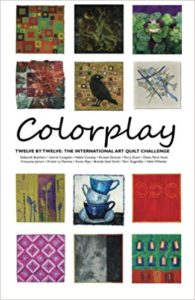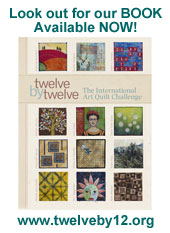My gray quilt doesn't actually have a bit of gray in it. As a graphic designer I often dealt with "grayscale" which is the effect, in printing, of shades of gray, achieved by printing black dots on white paper. The proportion of black to white, and the size of the black dots, determines the shade of gray you perceive. There is no gray ink in commercial printing. We also talk about text on pages as gray, with different typefaces and different spacing creating different shades of gray on the page. So I chose to create my "gray" piece by using black and white in different mixtures.
In this detail, you can see that the filigree-like figure is made up of printed text. This is actual print on paper (Time magazine as it happens) laminated to cotton fabric, making it sewable. The shadow behind the design was created by cutting the same design from tightly woven black cotton fabric, then placing a layer of loosely woven white cheesecloth over it to create a fine white grid pattern over the black.
This piece was my second "gray" piece. The first, below, was an interesting experiment, but less successful, in my opinion, as a finished piece. I went through my stash of solid colored fabrics one evening, in relatively low light, and pulled out four that looked gray. I stamped a repeating design on swatches of each of the "grays" and constructed my little piece. The next day I looked at the swatches in clear daylight and what had looked gray the night before was not necessarily neutral gray in the light of day! The purple was the biggest surprise. It had looked to be a very flat, colorless gray laying among all the stronger colors in my stash.
The name of this one is "Gray is relative" which is something I think we all discovered in the course of working with the color.
Rajah Award 2025
4 months ago






13 comments:
How did you laminate the paper to the cotton in the first one? and the cheese cloth to the black? The first one is wonderful, but I like the second one, too.
I found that there are all kinds of gray (blue-gray, green-gray, etc.) when trying to dye a "plain" gray.
I've posted my play-along piece on my blog: http://lisasartmusings.blogspot.com
Can't wait to see the rest.
I never would have thought looking at this that there was no gray in it. What a great use of black and white to "fool" our eyes.
I saw this in person yesterday. It is a wonderful piece and really does trick the eye. The quilting in the second piece is fantastic, but it does not read gray like the black and white does.
When I was working as a graphic designer, it was very important to choose the right grey -- not necessarily the most color-neutral grey, but the appropriate neutral for the job. So grey could/should be greenish, bluish, purply, warm or cool. There's pages of different Pantone swatches devoted to grey. So, I actually like seeing a piece like your first try, and Gerrie's piece that highlight this aspect of the color. It's OK that gray is relative.
That said, I really, really, like your texty snowflake piece. I totally get the grayscale/text is grey thing. I love the graphic quality of the piece. Beautiful and sophisticated.
This remind me of a French saying: "La nuit tous les chats sont gris."(at night all the cats are grey!) I guess this is what you experienced when your worked on your stamped piece. I love your final piece much better.
Annick
Oh! This is amazing, Terry. What's especially funny is that I messed around with newsprint pages thinking similarly but I never reached a shape or use for the print that I liked. This is, in my humble opinion, PERFECT.
I'm with Lisa Flowers Ross...how did you laminate the paper to the fabric? What a wonderful piece, and to think there is not a grey in sight only a slight of hand to produce the grey! As Diane said, Perfect.
I tore the text into smallish pieces, then glued them, using diluted white glue, to a piece of white cotton fabric. I brushed the back of each piece of paper with the glue and overlapped them a bit over the fabric. When all the pieces were down, I brushed some of the diluted glue over the top of the paper as well. When the glue was dry, I laid the fabric, paper side down, on a teflon pressing sheet and pressed the fabric with a hot iron which helped flatten it all out and adhere all the edges well.
You can do the same thing using acrylic medium.
Terry, this is exquisite. The asymetrical composition distinguishes it from traditional scherenschnitte blocks and the shading creates depth. So clever!
I love the filigree/snowflake design. I would not have guessed there was no gray in it until you mentioned it. Great idea.
The snowflake idea fits in with the grey winter idea, too. It's a lovely design with only part of the snowflake visible. I like it.
It's so modern! I really love the shadow. It adds so much to the composition -- in addition to giving us another gray to appreciate. I also love how the text goes in all different directions. Great job, Terry!
Post a Comment